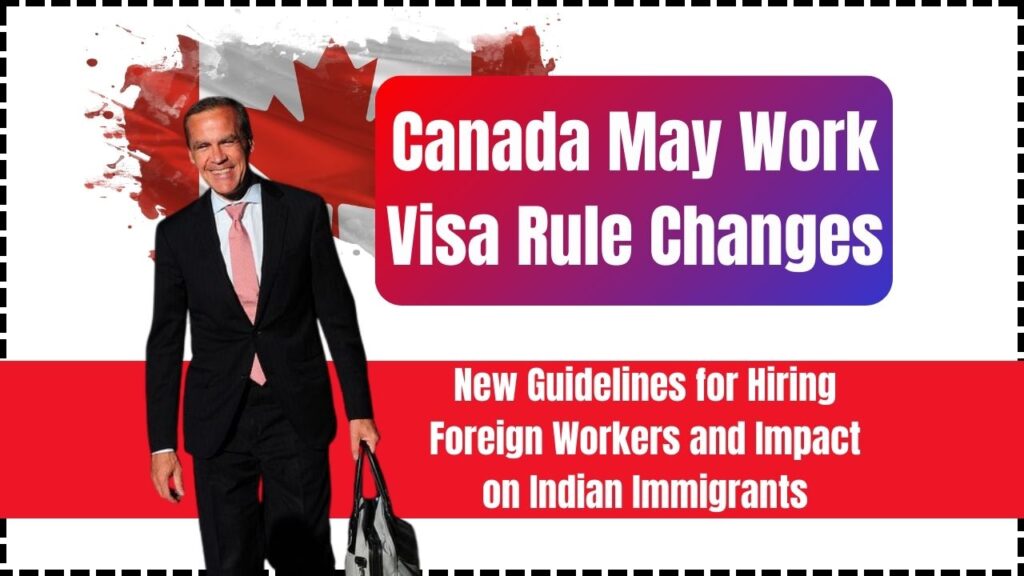Canada May Work Visa Rule Changes: Canada has always been a land of opportunities for skilled immigrants, especially from India. However, Canada May Work Visa Rule Changes in 2025 have brought significant updates that are reshaping the pathways for foreign workers and immigrants. These new guidelines have tightened eligibility for family members, reduced immigration targets, and given more discretion to immigration authorities, leaving many potential immigrants and employers reassessing their plans. If you are a student, professional, employer, or planning to move to Canada, it is crucial to understand these changes and how they may affect your journey.
Canada May Work Visa Rule Changes
Canada May Work Visa Rule Changes have introduced significant hurdles for foreign workers and Indian immigrants in 2025. The landscape is shifting toward favoring higher-skilled, sector-specific workers, and those already in Canada. Understanding these new policies, planning ahead, and seeking expert advice are now more critical than ever for anyone considering Canada as their new home.

| Policy Change | Details | Impact on Indian Immigrants |
|---|---|---|
| Stricter Eligibility for Family Open Work Permits (OWPs) | Only for spouses of master’s, PhD, select professional programs; workers in TEER 0/1 jobs | Reduced family reunification opportunities |
| Reduced Immigration Targets | 395,000 permanent resident admissions in 2025, fewer temporary residents | Fewer permanent residency pathways |
| Processing Delays and Status Loss | LMIA processing times up to 165 business days | Greater risk of losing work status |
| Enhanced Discretion for Border Authorities | Officers can deny/cancel temporary status if departure seems unlikely | Uncertainty for applicants |
Why Canada May Work Visa Rule Changes?
The Canadian government has cited several reasons for these changes:
- Labor Market Adjustments: High numbers of temporary workers have led to oversaturation in some industries, while shortages continue in others.
- Housing Shortage: Rapid population growth has worsened Canada’s housing affordability crisis.
- Public Sentiment: Rising concerns among Canadians regarding the economic and social impacts of high immigration levels.
- Economic Prioritization: Focus on critical sectors like healthcare, construction, and technology.
According to Statistics Canada, temporary residents accounted for 6.8% of the population in 2024, a historic high. The government aims to rebalance this to about 5% by 2027.
Stricter Eligibility for Family Open Work Permits (OWPs)
Effective January 21, 2025, only select groups can apply for Family OWPs:
- Spouses of international students in master’s, doctoral, or professional degree programs like law, medicine, or engineering.
- Spouses of foreign workers employed in TEER 0 or 1 occupations under the National Occupational Classification (NOC) system.
- Some spouses of TEER 2 or 3 workers if employed in priority sectors such as construction or healthcare.
Example: A spouse of a marketing assistant (TEER 4) will no longer qualify for an open work permit under the new rules.
Important: Dependent children are not eligible for work permits anymore under these categories.
Reduced Immigration Targets
Canada’s new Immigration Levels Plan for 2025-2027 projects:
- 395,000 new permanent residents in 2025 (down from 485,000 in 2024).
- Even lower targets in subsequent years.
- A sharp focus on people already in Canada with Canadian work or study experience.
This shift impacts Indian immigrants significantly, as India consistently remains Canada’s top source of immigrants.
Processing Delays and Status Loss
Work permit renewals now face longer wait times:
- LMIA (Labour Market Impact Assessment) processing has ballooned from 58 to 165 business days.
- Many foreign workers are losing their implied status due to permit expiry during processing.
- This jeopardizes access to healthcare and social services, with some workers facing deportation risks.
Employers are also struggling with workforce instability as critical roles remain unfilled.
Enhanced Discretion for Border Authorities
Under new regulations, immigration officers at ports of entry or during visa processing can:
- Deny or cancel study, work, or visitor permits if they believe the individual may not leave Canada after their authorized stay ends.
This creates unpredictability for applicants who were previously confident about meeting technical requirements.
How Employers Are Affected?
Canadian employers relying on temporary foreign workers must adjust:
- Recruitment will become more competitive for in-demand sectors (like construction, healthcare).
- Employers must offer higher wages and better working conditions to attract eligible workers.
- Navigating LMIA processes will require more advance planning to avoid labor shortages.
- Employers may need to explore Permanent Residence pathways like Express Entry earlier in the hiring process.
Real-Life Example: Impact on an Indian Family
An Indian student, Priya, studying for a two-year MBA in Toronto, planned to bring her husband on an open work permit. However, under the new rules, Priya’s MBA must be at least 16 months to qualify. Since her program is only 12 months, her husband is now ineligible for an open work permit. This forces the couple to reconsider their settlement plans in Canada.
Such stories are becoming increasingly common, especially among students from India who previously saw Canada as a highly welcoming destination.
Practical Tips to Adapt to Canada’s New Immigration Landscape
- Start Planning Early: Begin work permit renewals 6–8 months in advance.
- Consider Alternative Programs: Explore Provincial Nominee Programs (PNPs) targeting specific occupations.
- Focus on High-Demand Fields: Healthcare, construction, IT, and education offer better immigration prospects.
- Work with Authorized Consultants: Always consult RCICs (Regulated Canadian Immigration Consultants) for tailored advice.
Canada Care Assistant Program: Application Process & Get a Work Permit
Canada Work Permit 2025 – The New Rules to Get a Work Visa Without an Employer’s Involvement
Canada TFWP Reform: Stricter LMIA Rules & Job Categories Changing in 2025!
Frequently Asked Questions (FAQs)
Q1: Will these changes affect existing permit holders?
A: Generally, no. However, when renewing permits, new eligibility criteria apply.
Q2: Can dependent children work in Canada under the new rules?
A: No, dependent children are no longer eligible for open work permits.
Q3: What is LMIA, and why is it important?
A: LMIA (Labour Market Impact Assessment) is a document an employer needs to hire foreign workers. Processing delays have caused major disruptions.
Q4: How can employers cope with these changes?
A: Employers should streamline compliance, use LMIA-exempt streams if possible, and initiate PR sponsorships earlier.
Q5: What happens if my work permit expires while waiting for renewal?
A: You may lose implied status. It’s critical to apply well before expiry and consider restoration options if needed.








